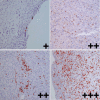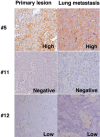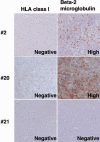Prognostic significance of HLA class I expression in osteosarcoma defined by anti-pan HLA class I monoclonal antibody, EMR8-5
- PMID: 16995877
- PMCID: PMC11158095
- DOI: 10.1111/j.1349-7006.2006.00317.x
Prognostic significance of HLA class I expression in osteosarcoma defined by anti-pan HLA class I monoclonal antibody, EMR8-5
Abstract
With the goal of establishing efficacious peptide-based immunotherapy for patients with bone and soft tissue sarcomas, we previously identified the cytotoxic T lymphocyte-defined osteosarcoma antigenic gene Papillomavirus binding factor. The present study was designed to determine the status of HLA class I expression in osteosarcoma and other bone and soft tissue sarcomas. Seventy-four formalin-fixed paraffin-embedded specimens of various bone and soft tissue sarcomas, including 33 osteosarcomas, were stained with the anti-HLA class I monoclonal antibody EMR8-5, which we recently generated. The expression of HLA class I was lost or downregulated in 46 of these specimens (62%). With respect to osteosarcoma, loss or downregulation of HLA class I expression was seen in 13 (52%) of 25 primary tumors and seven (88%) of eight metastatic tumors. In six of 11 HLA class I-negative osteosarcoma specimens, the expression of beta-2 microglobulin was also lost. Subsequently the prognostic significance of HLA class I expression was analyzed in 21 patients with osteosarcoma who had completed multidrug neoadjuvant chemotherapy and undergone adequate surgery. Patients with osteosarcoma highly expressing HLA class I showed significantly better overall and event-free survival than those with HLA class I-negative osteosarcoma. In contrast, such prognostic significance of HLA class I expression was not found in 15 patients with malignant fibrous histiocytoma of soft tissue. These findings suggest that the class I-restricted cytotoxic T lymphocyte pathway plays a major role in immune surveillance of patients with osteosarcoma.
Figures








Similar articles
-
Increased PD-L1 and T-cell infiltration in the presence of HLA class I expression in metastatic high-grade osteosarcoma: a rationale for T-cell-based immunotherapy.Cancer Immunol Immunother. 2017 Jan;66(1):119-128. doi: 10.1007/s00262-016-1925-3. Epub 2016 Nov 16. Cancer Immunol Immunother. 2017. PMID: 27853827 Free PMC article.
-
Prognostic impact and immunogenicity of a novel osteosarcoma antigen, papillomavirus binding factor, in patients with osteosarcoma.Cancer Sci. 2008 Feb;99(2):368-75. doi: 10.1111/j.1349-7006.2008.00695.x. Cancer Sci. 2008. PMID: 18271936 Free PMC article.
-
Prognostic significance of HLA EMR8-5 immunohistochemically analyzed expression in osteosarcoma.Diagn Pathol. 2014 Mar 25;9:72. doi: 10.1186/1746-1596-9-72. Diagn Pathol. 2014. PMID: 24667142 Free PMC article.
-
Therapeutic Targets for Bone and Soft-Tissue Sarcomas.Int J Mol Sci. 2019 Jan 4;20(1):170. doi: 10.3390/ijms20010170. Int J Mol Sci. 2019. PMID: 30621224 Free PMC article. Review.
-
[Pulmonary metastasectomy for osteosarcomas and soft tissue sarcomas].Gan To Kagaku Ryoho. 2004 Sep;31(9):1319-23. Gan To Kagaku Ryoho. 2004. PMID: 15446550 Review. Japanese.
Cited by
-
Adoptive cell therapy for sarcoma.Immunotherapy. 2015;7(1):21-35. doi: 10.2217/imt.14.98. Immunotherapy. 2015. PMID: 25572477 Free PMC article. Review.
-
Pathways of immune exclusion in metastatic osteosarcoma are associated with inferior patient outcomes.J Immunother Cancer. 2021 May;9(5):e001772. doi: 10.1136/jitc-2020-001772. J Immunother Cancer. 2021. PMID: 34021032 Free PMC article.
-
The immune microenvironment of uterine adenosarcomas.Clin Sarcoma Res. 2020 Mar 28;10:5. doi: 10.1186/s13569-020-0127-0. eCollection 2020. Clin Sarcoma Res. 2020. PMID: 32231779 Free PMC article.
-
Specific targeting of a naturally presented osteosarcoma antigen, papillomavirus binding factor peptide, using an artificial monoclonal antibody.J Biol Chem. 2014 Aug 8;289(32):22035-47. doi: 10.1074/jbc.M114.568725. Epub 2014 Jun 24. J Biol Chem. 2014. PMID: 24962571 Free PMC article.
-
Immune Checkpoint Inhibitory Therapy in Sarcomas: Is There Light at the End of the Tunnel?Cancers (Basel). 2021 Jan 19;13(2):360. doi: 10.3390/cancers13020360. Cancers (Basel). 2021. PMID: 33478080 Free PMC article. Review.
References
-
- Arndt CA, Crist WM. Common musculoskeletal tumors of childhood and adolescence. N Engl J Med 1999; 341: 342–52. - PubMed
-
- Singer S, Demetri GD, Baldini EH, Fletcher CD. Management of soft‐tissue sarcomas: an overview and update. Lancet Oncol 2000; 1: 75–85. - PubMed
-
- Meyers PA, Schwartz CL, Krailo M et al. Osteosarcoma: a randomized, prospective trial of the addition of ifosfamide and/or muramyl tripeptide to cisplatin, doxorubicin, and high‐dose methotrexate. J Clin Oncol 2005; 23: 2004–11. - PubMed
-
- Ferrari S, Smeland S, Mercuri M et al. Neoadjuvant chemotherapy with high‐dose ifosfamide, high‐dose methotrexate, cisplatin, and doxorubicin for patients with localized osteosarcoma of the extremity: a joint study by the Italian and Scandinavian Sarcoma Groups. J Clin Oncol 2005; 23: 8845–52. - PubMed
-
- Marcove RC. A clinical trial of autogenous vaccines in the treatment of osteogenic sarcoma. Beitr Pathol 1974; 153: 65–72. - PubMed
Publication types
MeSH terms
Substances
LinkOut - more resources
Full Text Sources
Other Literature Sources
Medical
Research Materials

